Proper facial cleansing is crucial for maintaining skin health, preventing acne, and ensuring effective absorption of skincare products. It removes dirt, oil, and other pollutants that accumulate on the skin throughout the day.
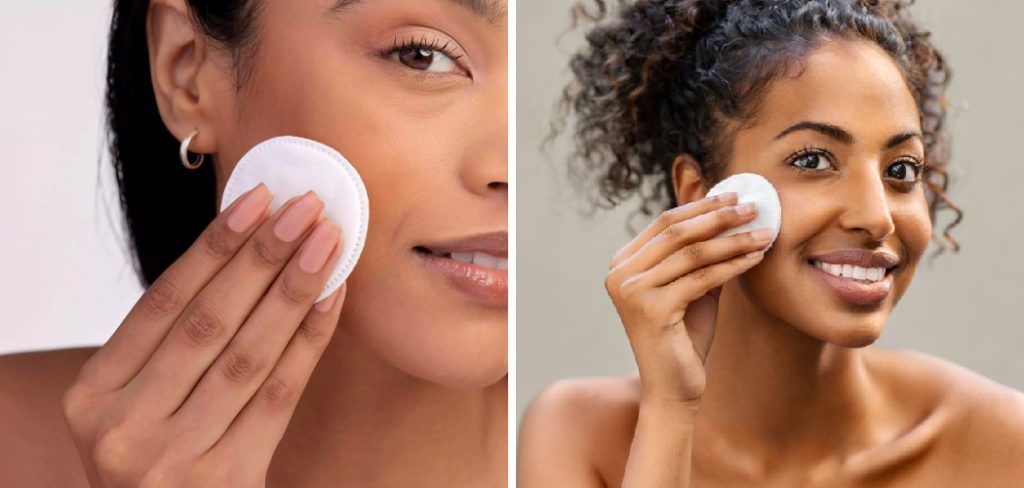
Cleansing pads are designed to simplify the skincare routine, offering a convenient, effective way to cleanse the face. They come in various types, each suited for different skin concerns and goals.
This guide aims to provide comprehensive insights on how to use cleansing pads for face, offering advice on selecting the right type for your skin, optimizing your cleansing routine, and addressing common skincare concerns.
Understanding Cleansing Pads
A. Types of Cleansing Pads
Cleansing pads come in various materials and textures to cater to different skincare needs. Cotton pads are soft and gentle, making them ideal for everyday use and suitable for all skin types. Microfiber pads boast ultra-fine fibers that effectively capture and remove dirt and makeup, offering a deeper cleanse. Exfoliating pads contain textured surfaces or ingredients designed to remove dead skin cells, aiding in cell turnover and revealing a brighter complexion.
B. Ingredients and Formulations
The efficacy of cleansing pads also depends heavily on their ingredients and formulations. Hydrating pads may be infused with glycerin or hyaluronic acid to retain moisture, while those targeting acne-prone skin might contain salicylic acid or tea tree oil for their antimicrobial properties. For exfoliation, ingredients like alpha-hydroxy acids (AHAs) or beta-hydroxy acids (BHAs) are common, offering chemical exfoliation that is effective yet mild on the skin.
C. Benefits for Different Skin Types
Choosing the right cleansing pad can provide numerous benefits tailored to specific skin types. For oily and acne-prone skin, pads formulated with BHAs help in unclogging pores and reducing breakouts. Dry skin benefits from moisturizing ingredients that leave the skin soft without stripping away natural oils. Sensitive skin types should look for hypoallergenic pads with minimal ingredients to reduce the risk of irritation. Ultimately, the correct type of cleansing pad can enhance any skincare routine, promoting a clean, healthy complexion irrespective of skin type.
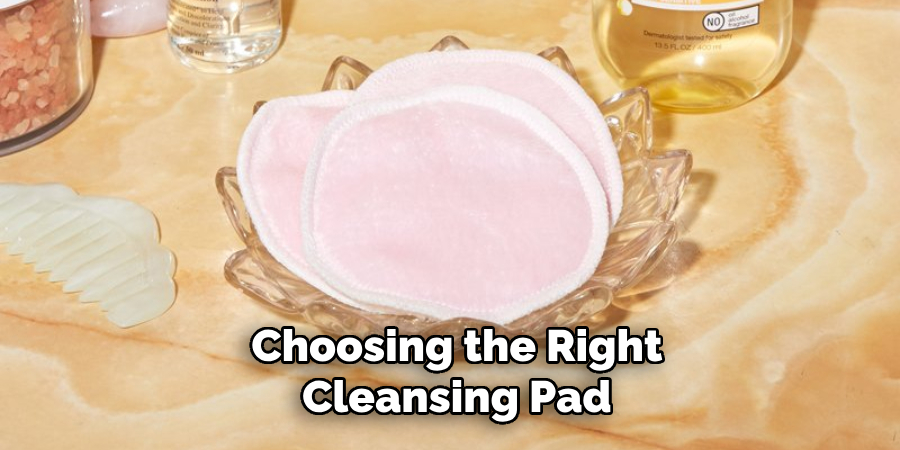
Preparing Your Skin
Before introducing cleansing pads into your routine, preparing your skin properly is essential to maximize their benefits.
A. Washing Hands Thoroughly
Begin by washing your hands with soap and warm water for at least 20 seconds. This step is crucial to remove any dirt, oil, or bacteria from your hands that could be transferred to your face, ensuring a clean start and preventing the spread of germs.
B. Wetting the Face with Lukewarm Water
Once your hands are clean, gently wet your face with lukewarm water. Hot water can strip the skin of its natural oils, leading to dryness, while cold water might not effectively open up the pores. Lukewarm water helps to soften the dirt and sebum on your face, making it easier for the cleansing pad to clean the skin thoroughly.
C. Selecting the Right Cleansing Pad for Your Skin
Choosing the appropriate cleansing pad for your skin type and concerns is vital. Consider what you aim to achieve with your skincare routine—is it to moisturize, exfoliate, or target acne? For example, look for a pad with hydrating ingredients if you have dry skin. If you aim to exfoliate, select a pad designed for that purpose. Reading the labels and understanding the ingredients and their benefits can guide you to the best option for your skin, ensuring optimal results from your cleansing routine.
How to Use Cleansing Pads for Face: Using Cleansing Pads
A. Daily Cleansing Routine
- Applying Cleansing Pad to Face
Begin your skincare regimen by lightly wetting the cleansing pad with water if it’s dry, or simply take a pre-moistened pad from the package. This ensures the pad is prepared to cleanse the skin effectively.
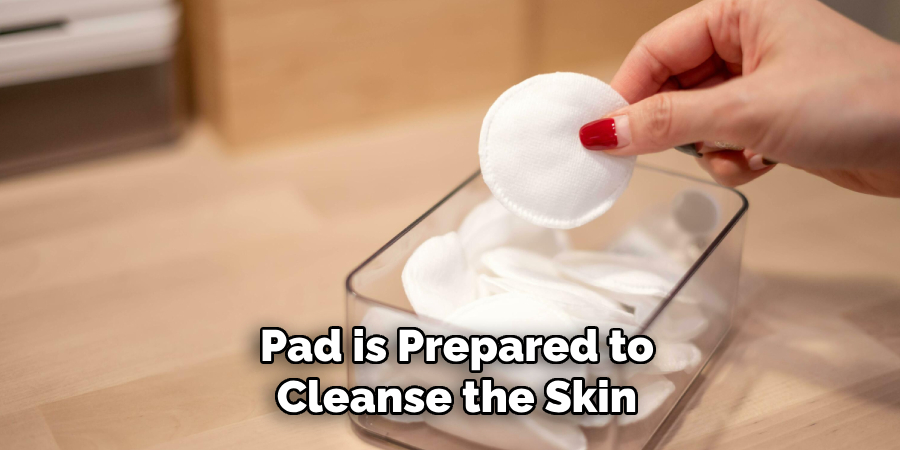
- Gently Massaging in Circular Motions
With the pad in hand, gently massage your face in a circular motion. Start from the center of your face and move outwards towards the edges. This method helps uplift and efficiently remove dirt, oil, and dead skin cells without stressing the skin.
- Targeting Problem Areas (e.g., T-Zone, Cheeks)
Pay special attention to areas where dirt and oil tend to accumulate, such as the T-zone (forehead, nose, and chin) and cheeks. Applying a bit more focus and additional gentle circular motions in these areas can help ensure a thorough cleanse.
B. Removing Makeup
- Choosing Suitable Cleansing Pads for Makeup Removal
Ensure you’re using a cleansing pad designed to remove makeup. These are typically softer and may contain ingredients specifically formulated to break down makeup, including waterproof mascara and eyeliner.
- Holding Pad Over Eye Area to Dissolve Makeup
For eye makeup removal, gently press the pad against the eyelid and lashes for a few seconds. This gives the solution time to dissolve the makeup, making it easier to wipe away without rubbing harshly or causing irritation.
- Wiping Away Makeup Residue
After allowing the product to dissolve the makeup, softly wipe away the residue in a downward stroke. You may need to use a fresh side of the pad or an additional pad to ensure all makeup is fully removed.
C. Exfoliation
- Selecting Exfoliating Cleansing Pads
Choose a cleansing pad specifically designed for exfoliation. These may contain physical exfoliants (e.g., textured surfaces) or chemical exfoliants (e.g., AHAs, BHAs) to help remove dead skin cells, promoting a smoother and more radiant complexion.
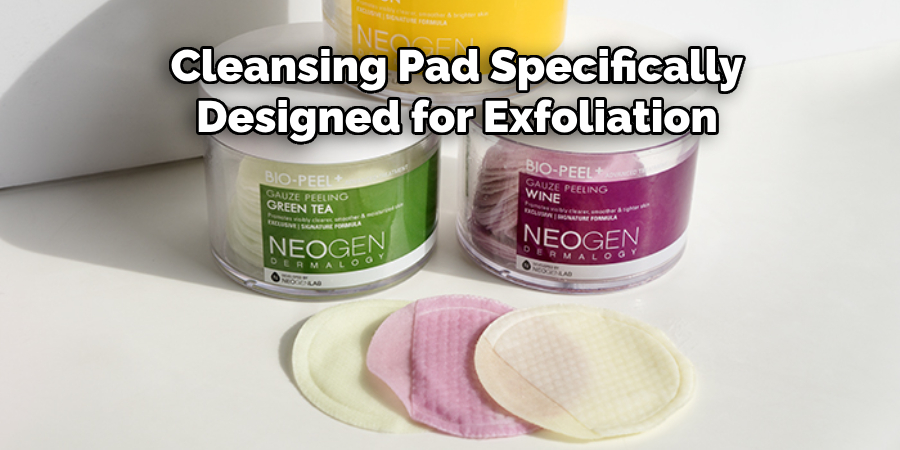
- Using Light Pressure to Avoid Irritation
When using an exfoliating pad, apply light pressure to avoid skin irritation. Gentle, circular motions across the face are sufficient to engage the exfoliating benefits without causing harm to the skin barrier.
- Limiting Exfoliation to 2-3 Times per Week
To maintain skin health and prevent over-exfoliation, it’s advisable to limit the use of exfoliating cleansing pads to 2-3 times per week. This frequency allows the skin to rejuvenate and maintain a balanced state without over-stripping natural oils or causing sensitivity.
How to Use Cleansing Pads for Face: Post-Cleansing Care
After thoroughly cleansing your face with a cleansing pad, it’s essential to follow up with proper post-cleansing care to ensure your skin remains healthy, balanced, and hydrated.
A. Rinsing Face with Lukewarm Water
Immediately after using your cleansing pad, rinse your face with lukewarm water. This step helps to remove any remaining residue from the cleanser and refreshes the skin. Remember, just like in the preparation stage, lukewarm water is ideal as it doesn’t shock your skin or strip it of its natural oils.
B. Patting Skin Dry with a Clean Towel
Gently pat your skin dry with a clean, soft towel. It’s important to be gentle and not rub the skin, as rubbing can cause irritation and exacerbate skin issues. Patting your skin allows it to retain some moisture, which is beneficial before applying any post-cleansing products.
C. Following Up with Toner or Serum
After cleansing and drying, apply a toner or serum suited to your skin type and concerns. Toner helps to balance the skin’s pH and remove any remnants of dirt or makeup, preparing the skin to absorb additional products more effectively. A serum, depending on its formulation, can provide targeted treatment – such as hydration, brightening, or anti-aging benefits. This step is crucial as it ensures that your skin is receiving all the beneficial ingredients it needs to stay healthy and radiant.
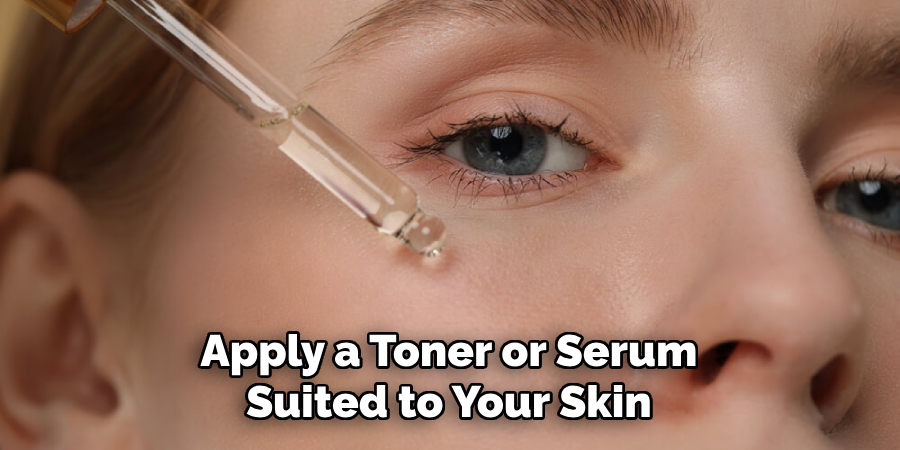
Targeted Treatments
A. Acne-Prone Skin
- Using Salicylic Acid Cleansing Pads
Salicylic acid is a beta-hydroxy acid renowned for penetrating deeply into the pores, dissolving excess sebum, and exfoliating the skin’s surface. For those battling acne, cleansing pads infused with salicylic acid can significantly reduce breakouts and prevent future pimples by keeping the pores clear.
- Spot Treating Problem Areas
In addition to regular cleansing, directly applying salicylic acid pads to blemishes or prone areas can intensify the treatment, targeting the root of the problem. This method ensures that the active ingredients work precisely where needed without over-drying unaffected areas.
- Avoiding Overuse to Prevent Dryness
While effective, salicylic acid can lead to dryness if overused. Individuals with acne-prone skin must balance the use of these cleansing pads with hydrating skincare products. Limiting use to once a day or every other day, depending on skin tolerance, can prevent adverse effects.
B. Aging Skin
- Choosing Anti-Aging Formulations
Cleansing pads designed for aging skin often contain ingredients like retinol, peptides, and antioxidants. These compounds work together to stimulate collagen production, fight free radicals, and smooth fine lines and wrinkles, offering a rejuvenated complexion.
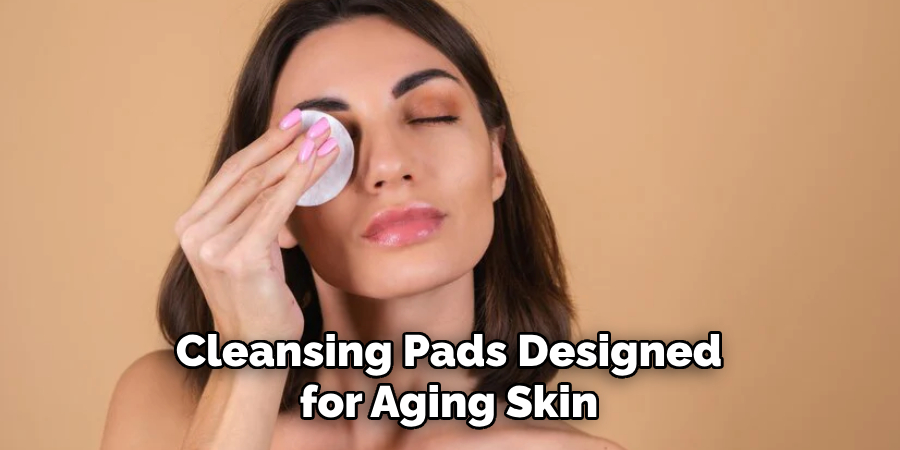
- Massaging in Upward Motions for Firming Effect
When applying anti-aging pads, use gentle, upward strokes. This technique encourages firmer skin by combating the natural downward pull of gravity, aiding in the lifting and tightening of the skin’s appearance.
- Incorporating Hydrating Ingredients
Additional hydration benefits aging skin immensely. Look for cleansing pads enriched with hyaluronic acid, glycerin, or ceramides. These ingredients help lock in moisture, plumping the skin and reducing the visibility of lines and wrinkles.
C. Sensitive Skin
- Opting for Gentle Formulations
For those with sensitive skin, choosing cleansing pads free of harsh chemicals, fragrances, and alcohol is vital. Gentle formulations that contain soothing ingredients, like aloe vera or chamomile, can effectively cleanse the skin without causing irritation.
- Performing Patch Test Before Use
Before committing to a new cleansing pad, it is recommended to perform a patch test on an inconspicuous area to ensure no adverse reactions occur. This precautionary step can prevent potential irritation or allergic reactions on the face.
- Using Minimal Pressure During Application
Applying gentle pressure during cleansing minimizes the risk of aggravating sensitive skin. Soft, sweeping motions allow the pad to cleanse effectively without scratching or irritating the skin’s surface.
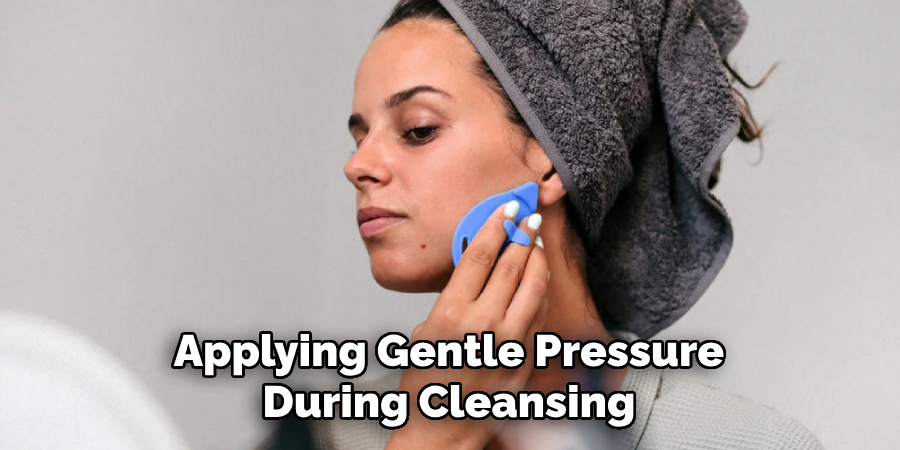
That’s it! Now you have all the necessary information to properly use cleansing pads for your face. Remember to always choose high-quality products suitable for your skin type and concerns, follow proper post-cleansing care, and listen to your skin’s needs to achieve a radiant, healthy complexion. With regular exfoliation and targeted treatment, you can say goodbye to dull, uneven skin and hello to a brighter, smoother, and rejuvenated complexion. So go ahead and incorporate cleansing pads into your skincare routine for a fast, convenient, and effective way to maintain healthy, glowing skin!
Maintenance and Storage
Proper maintenance and storage of cleansing pads are essential for ensuring they remain effective and hygienic for every use.
A. Keeping Cleansing Pads Sealed in Packaging
Keeping cleansing pads sealed in their original packaging is imperative to prevent them from drying out. Once the seal is broken, make sure to close the package securely after each use. For products with a resealable sticker or flap, press firmly along the edges to secure the closure and retain the moisture of the pads.
B. Storing in a Cool, Dry Place
Cleansing pads should be stored in a cool, dry place, away from direct sunlight and heat sources. Excessive heat or direct sun exposure can degrade the quality of the active ingredients in the pads, reducing their effectiveness. A bathroom cabinet or drawer is typically ideal for keeping them in an optimal environment.
C. Checking Expiration Dates Regularly
Like all skincare products, cleansing pads have an expiration date that should be adhered to. Using expired products can lead to skin irritation or diminished efficacy. It’s a good practice to check the expiration dates regularly and replace any products that are past their prime. Note the purchase date on the packaging with a permanent marker as a helpful reminder of when to check for expiration.
Troubleshooting
A. Addressing Irritation or Sensitivity
Experiencing irritation or sensitivity after using cleansing pads is not uncommon. Should this occur, immediately cease using the product and switch to a mild cleanser with minimal ingredients to help calm your skin. Applying a soothing moisturizer containing ingredients like aloe vera or ceramides can also alleviate discomfort. For persistent irritation, hydrocortisone cream may be used sparingly, but it’s advisable to consult a dermatologist before application.
B. Adjusting Frequency of Use
If signs of overuse, such as dryness or peeling, appear, it may be necessary to adjust the frequency of use. Start by reducing the application to every other day or just a few times a week, allowing your skin time to adjust. Pay attention to how your skin responds and gradually find a balance that maintains its health without causing irritation. For particularly harsh active ingredients like salicylic acid or retinol, integrating them slowly into your routine can prevent adverse reactions.
C. Seeking Professional Advice if Necessary
Persistent skin issues after the adjustment of cleansing pad usage warrant professional advice. Dermatologists can provide tailored recommendations based on an individual’s skin type, concerns, and reactions to specific ingredients. They may also suggest alternative treatments or products that could be more beneficial. Remember, what works for one person may not work for another, and professional guidance is invaluable in navigating the vast world of skincare.
Environmental Considerations
A. Choosing Eco-Friendly Options
In an effort to reduce ecological impact, selecting eco-friendly cleansing pads is a step toward more sustainable skincare routines. Look for products made from biodegradable materials or those certified by environmental organizations. Brands that prioritize sustainable sourcing and manufacturing practices and use minimal and recyclable packaging also contribute to a lower environmental footprint.
B. Proper Disposal of Used Pads
Proper disposal of used cleansing pads is crucial in minimizing waste. Non-biodegradable pads should be thrown in the trash, while biodegradable options may have specific disposal instructions to follow for optimal decomposition. Avoid flushing cleansing pads down the toilet, as this can cause blockages and contribute to water pollution.
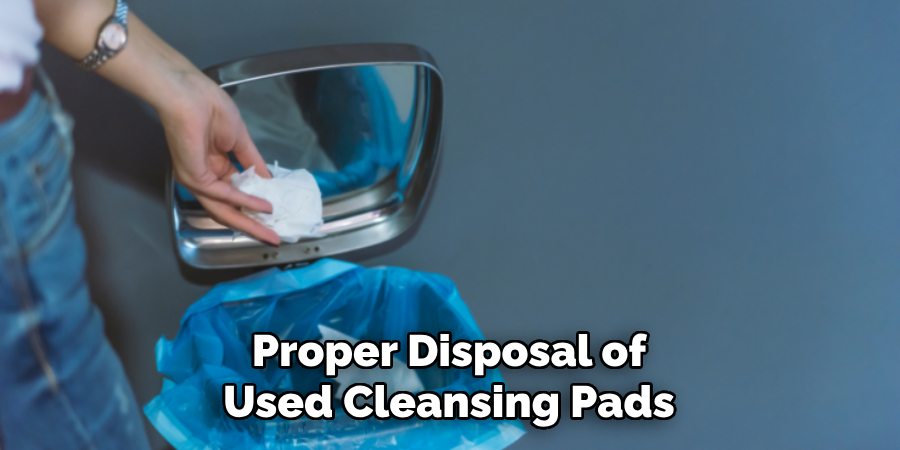
C. Opting for Reusable Pads When Possible
Reusable cleansing pads offer an effective and environmentally friendly alternative to disposable options. Made from materials like cotton or bamboo, these pads can be washed and reused multiple times, significantly reducing waste. Integrating reusable pads into your skincare routine not only aligns with eco-conscious values but also proves to be cost-effective in the long run.
Conclusion
This guide has navigated through the essentials of selecting, using, and maintaining facial cleansing pads. From choosing the right product for your skin type to the importance of gentle application and proper storage, each step emphasized has been designed to optimize your skincare routine while ensuring the health and beauty of your skin.
Adhering to a consistent skincare routine is crucial for maintaining healthy, vibrant skin over time. Introducing cleansing pads into your regimen can elevate your skin’s cleanliness and freshness, provided they are used correctly and consistently. Remember, patience and persistence are key to seeing long-term results.
Understanding how to use cleansing pads for face effectively is pivotal in achieving clear, refreshed skin. Starting with a gentle cleanser, then moving on to a quality skincare pad that matches your skin type, and finishing with a moisturizer suitable for your skin’s needs can revolutionize your skincare routine. The correct use of cleansing pads can remove dirt, oil, and makeup, leaving your skin feeling clean and revitalized. By following the guidelines outlined in this document, you can maximize the benefits of your cleansing pads and maintain a radiant complexion.
About the Author
Jane Hubbard is a passionate beauty expert with a wealth of experience in makeup, hair, and overall beauty techniques. After years of working as a hairdresser specialist, she followed her entrepreneurial spirit and started her own consultancy business.
Jane has always been driven by her desire to help others feel confident in their own skin, and she does this by sharing her knowledge, experiences, and practical beauty tips. Through her consultancy, she empowers individuals to embrace their unique beauty, offering tailored guidance that boosts both self-esteem and personal style.
Professional Focus
- Specializes in makeup, hairstyling, and beauty consulting.
- Provides personalized beauty advice, tips, and techniques to help individuals feel confident in their appearance.
- Dedicated to staying up-to-date with the latest industry trends and developments.
- Passionate about creating a comfortable and empowering experience for every client.
Education History
- University of Craft and Design – Bachelor of Fine Arts (BFA) in Woodworking and Furniture Design
- Woodworking Apprenticeships – Extensive hands-on training with skilled craftsmen to refine carpentry and furniture making techniques
- Online Courses & Masterclasses – Continued education in advanced woodworking techniques, design principles, and specialized tools
Expertise:
- Makeup artistry, hairstyling, and beauty consulting.
- Personalized beauty techniques to enhance confidence and self-expression.
- Educating clients on how to maintain their beauty routines at home.
